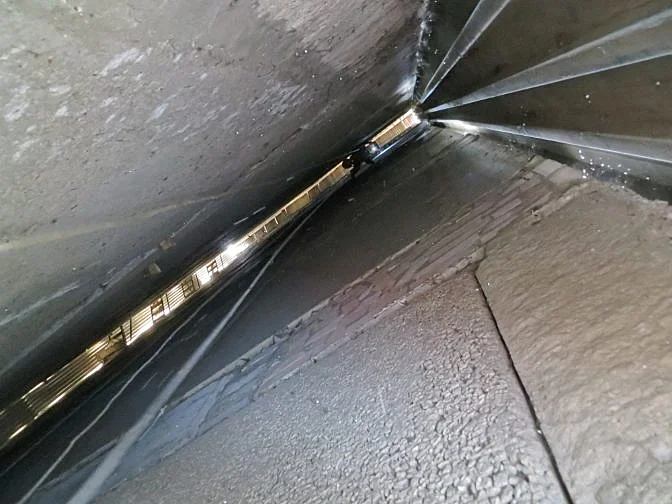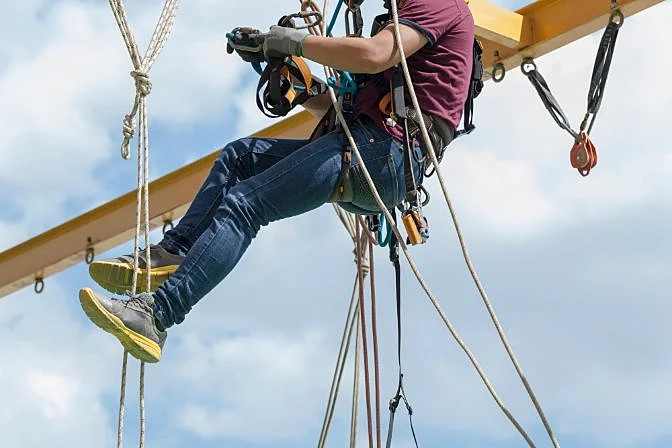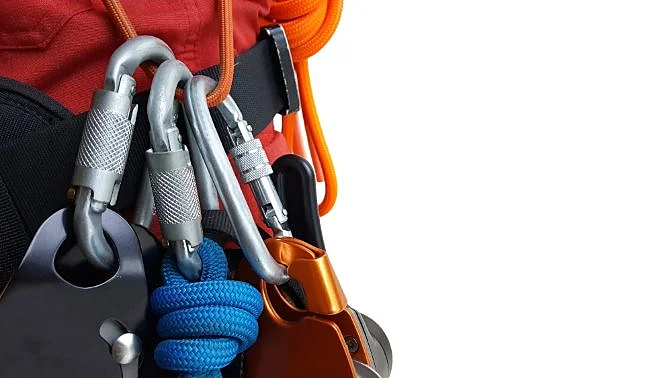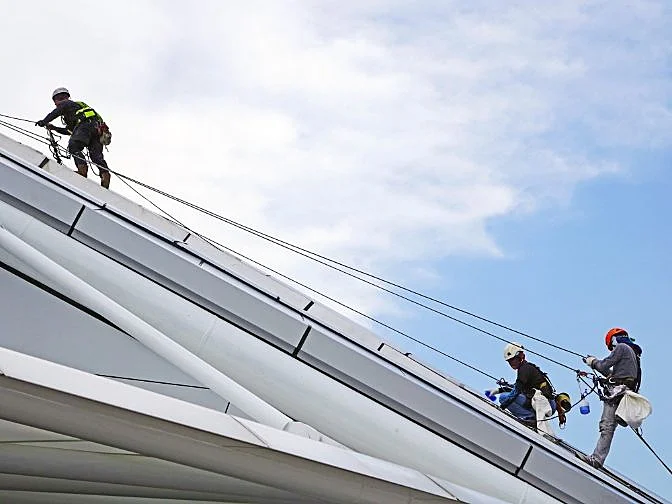- Articles & More >
- Blog >
- What Is Rope Access?
What Is Rope Access?
Rope access is the professional use of ropes to do inspections, maintenance, and other types of work.
The use of ropes in industrial settings was pioneered by explorers who first used ropes in caving and climbing, and has since been adapted for many different types of work.
To gain access to inaccessible areas, rope access is commonly used along with various climbing techniques and—of course—safety equipment. It’s also used in challenging or dangerous environments like confined spaces, on work sites above water, or in limited spaces within buildings, allowing people to work at height safely and efficiently while avoiding obstacles.
[Rope access is commonly used for non-destructive testing, also known as NDT. Learn more about NDT in this in-depth guide.]

What Is Rope Access?
The primary purpose of ropes access is to enable workers to access difficult-to-reach locations without scaffolding, cradles, or aerial platforms.
A rope access technician will use ropes to descend, ascend, or traverse ropes while held in place by a harness, and sometimes a rope access work seat as well.
Rope access first came into use for industrial work in the 1980s. Since then, trade associations like IRATA (Industrial Rope Access Trade Association) and SPRAT (Society of Professional Rope Access Technicians) have codified it and made it into a tested, reliable method for getting people into hard-to-reach places to do work.
These days, there is a wide array of rope access works and jobs that involve rope access.
In the civil sector, for instance, the most common uses are window cleaning, maintenance, and support.
In the industrial sectors, the most common uses are non-destructive testing (also simply known as inspections).
To satisfy rope access safety requirements, rope technicians commonly use a few different redundancies to ensure they’ll still be safe in case part of their equipment fails.
Two common redundancies are:
-
A backup fall arrest system, which uses two ropes to provide a redundancy for safety—a working rope and a safety rope.
-
Additional anchor points—a primary anchor point + two backup anchor points.
The main advantage of using ropes access lies in the speed and safety with which they allow workers to reach hard-to-reach locations in order to perform their work, often with minimal impact on other operations and surrounding areas.
Comparing the man-at-risk hours and associated risks and costs of access to such locations with other means of access, rope access generally reduces both the time workers are exposed to risk and the degree of that risk.

The Pros and Cons of Rope Access
Pros
-
Accessibility. A rope access solution can always be found to reach an 'inaccessible' place, whether it is in height or depth.
-
Safety. Working at height is generally a safe activity when conducted according to IRATA guidelines.
-
Speed. A rope access system can be quickly constructed and dismantled. Because of this, it can be quickly set up and taken down when needed. There is very little inconvenience.
-
Space. Compared to other methods for reaching challenging areas at height, rope access takes up very little space, which means that it doesn’t pose a significant disruption to a work site.
-
Environmental considerations. Rope methods are considered environmentally friendly because they don’t require the transportation of large machinery, and because they allow people to reach worksite locations without clearing or adapting land.
Cons
-
Perception. Although rope access is generally safe, many companies still feel wary about it because they have a perception that it is dangerous.
-
Access. Ropes do not allow access to every single area where a person might need to go for the purposes of work.
-
Directional limitations. Rope access systems are not powered, which means that they only allow a technician to go down, and not back up.
-
Maintenance work limitations. Working on ropes limits the abilities for a person to do certain types of maintenance work, making some kinds of more intensive work impossible.
Rope Access Techniques and Systems
Here are the steps rope technicians generally take when doing their work:
-
Preparation. This includes assessing potential risks for a given mission, establishing preventative measures as needed, and installing anchoring points and progression points (if they’re not already in place).
-
Placement. Progress towards and away from the operating level, then getting positioned in the area where work will be done.
-
Implementation. Doing the work required—conducting an inspection, cleaning, maintenance, or whatever other kind of work is needed.
-
Debriefing and cleaning. Going over anything learned from the mission from a safety perspective and removing anchors and progression systems (unless regular activity requires them to stay in place).
Industrial Rope Access Systems
There are two common types of rope access systems, which are often used at the same time.
Note: When we say system here, we’re referring to a general approach to how the work is done, not a defined methodology.
The Dual Rope System
This is the system we referred to above, which uses redundancy to ensure safety. Using a Dual Rope System, a rope technician will have a primary rope and a secondary rope, with the second one in place as a backup in case the first one fails. The primary and secondary rope systems must always have at least two secure attachment points.
The Buddy System
The Buddy System is commonly used in conjunction with the Dual Rope System. It refers to the use of partners in rope work, so that rope technicians can rescue each other if one gets into trouble while working at height.
The Buddy System allows partners to rescue each other, while the Dual Rope System allows horizontal movement and self-rescue.

Rope Access Equipment List
There are many different types of equipment used in rope access work. Much of this equipment is explicitly designed to help satisfy rope access safety requirements and keep inspectors safe while working.
Here are the most common types of rope access equipment.
Ascenders
An ascender allows you to climb ropes.
This type of hitch works much like a friction hitch, sliding along the rope while empty, then locking into place when weight is applied. Unlike friction hitches, ascenders are mechanical and are safer and much easier to use.
Descenders
Workers or loads are lowered by using descenders, allowing them to do so at a controlled rate. This is achieved by using friction, just as ascenders do. Descenders should have a self-braking mechanism and an operator release mechanism.
Lanyards / Energy Absorbers
Harnesses are linked to anchors using lanyards and energy absorbers. A fall arrest system is the most prevalent type used in the industry, and it’s designed to reduce the force on the body in the case of a fall.
Harnesses
Types of harnesses used in rope access include full-body harnesses and seat harnesses. Full-body harnesses are more commonly used in rescue or industrial applications due to the number of attachment points they provide.
Helmets
Helmets provide protection against falling debris and other head-related hazards associated with rope access. Even though safety harnesses are mandatory on all construction sites, they are especially important when working at heights. This is essential to prevent orthostatic hypotension due to a restriction of blood flow if a worker has an accident that leads to a loss of consciousness.
Ropes
There would be no rope access without ropes. As well as being strong, ropes are lightweight and flexible.
This is not an exhaustive list of every piece of equipment used in rope access—other types include connectors, foot loops, mobile fall arrest devices, and pulleys.
Rope Access Training
Training and qualifications required to get started in rope access can seem daunting—and with good reason.
Work on ropes is inherently dangerous. For that reason, rope access safety requirements and training to satisfy them are highly emphasized throughout the industry.
Both IRATA and SPRAT have mandatory training policies, as well as stringent reporting requirements for all members.

Certification Levels
There are three generally recognized certification levels for rope access training, each with different content and criteria.
Here is how these three technical grades are described by IRATA:
-
Level 1. This level covers a variety of rope access maneuvers, the inspection of rigging equipment, and basic rescue procedures.
-
Level 2. This level builds on level 1 training and teaches rope rigging, safety requirements, rescues, and quality assurance procedures.
-
Level 3. This level teaches the most advanced rescue techniques and best practices, and allows rope technicians to work as site supervisors. A level 2 supervisor must log 1,000 hours on the ropes before attaining Level 3 certification.
In addition to training, a candidate’s health, fitness, strength, and coordination levels may also be considered as part of the certification process.
Learn more about the three training levels listed above on the IRATA website.
Preparing for training
To make sure you're not totally in the dark, it's a good idea to brush up on some basic knowledge before you begin formal training.
Learn a little about work at height regulations, and familiarize yourself with some of the knots and supplies you will be using during rope access work. The rope access course is designed to introduce you to all the basics of rope access, but it's better to begin training with some fundamental knowledge already in place.
The Training
It takes five days to complete a rope access training course.
Even if you have experience rock climbing or using ropes in some other capacity, it’s important to pay attention when entering rope access training since there are specific considerations for using ropes in a work environment.
While practical exercises are a major part of the training, theoretical lessons are also important and commonly taught during breaks between the exercises.
The Assessment
There are written and practical assessments at the end of each training course.
Assessments are conducted to ensure that trainees understand their responsibilities and can perform tasks safely as a team.
Here are some of the types of exercises that might be included in a rope access assessment:
-
How to assemble a harness rig
-
How to check equipment for faults
-
How to perform rescue maneuvers
-
The types of knots that can be tied
-
Rope climbing
Throughout every maneuver, it is important to avoid dangling from only one rope without any backup, and to check that the mainline and safety line are both secure at every step of the process.

